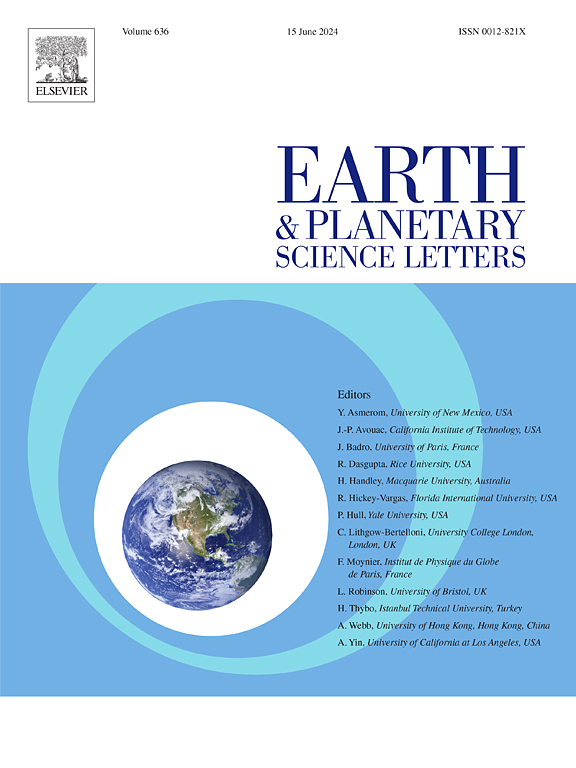Seismic radial anisotropy in southeastern Tibetan Plateau and its implications for regional geodynamic evolution
IF 4.8
1区 地球科学
Q1 GEOCHEMISTRY & GEOPHYSICS
引用次数: 0
Abstract
The southeastern Tibetan Plateau exhibits intricate crustal tectonics, encompassing recent seismic megathrust events. Previous research suggested the presence of north-south-oriented channelized viscous flow within the crust. However, recent investigations have unveiled a notable northeast-southwest-oriented geological structure, potentially rigid, intersecting with the presumed crustal channelized flow. Several questions persist regarding the composition of the northeast-southwest-oriented structure, the continuity of crustal channelized flow, and the interplay between them. In this study, dispersion data from a dense seismic array are employed to significantly refine regional crustal models for shear wave velocity and radial anisotropy through ambient noise tomography. The resulting high-resolution model further reveals the style of the crustal deformation and supports the interpretation that the northeast-southwest structure, which shows higher velocity and significant negative radial anisotropy, results from mafic material at the base of crust, obstructing the crustal channelized flow. However, the northeast-southwest structure is not as rigid as the Sichuan Block and exhibits depth-dependent deformation. The interpretation proves useful in further understanding regional earthquake focal mechanisms and strain distribution. Additionally, this research identified a region of generalized negative radial anisotropy in the crust of the western Chuan-Dian fragment, suggesting a reduced horizontal channel crustal flow in this area. Drawing upon various geophysical and geological evidence, we present a geodynamic evolution model, proposing a sequence of events: Permian plume activity resulting in mafic material at the base of the crust near Anninghe-Zemuhe fault, northward advancement of the east Himalayan syntaxis inducing crustal compressional stress field, reduced lower crustal channel flow in the western Chuan-Dian fragment leading to the regional east-west extension, and initiation of the Xianshuihe fault causing shift of strain concentration and depth-dependent deformation near the Anninghe-Zemuhe fault. The geodynamic model provides valuable insights into the regional distribution of crustal strain and the underlying mechanisms of large seismic events.
青藏高原东南部地震径向各向异性及其对区域地球动力演化的影响
青藏高原东南部呈现出错综复杂的地壳构造,包括近期发生的地震大断裂事件。以前的研究表明,地壳内存在南北走向的渠化粘性流。然而,最近的调查揭示了一个显著的东北-西南走向地质结构,它可能是刚性的,与假定的地壳通道流相交。关于东北-西南向结构的组成、地壳通道化流动的连续性以及它们之间的相互作用,仍然存在一些问题。在这项研究中,利用密集地震阵列的频散数据,通过环境噪声层析成像,极大地完善了剪切波速度和径向各向异性的区域地壳模型。由此产生的高分辨率模型进一步揭示了地壳变形的风格,并支持了以下解释:东北-西南构造显示出较高的速度和显著的负径向各向异性,是地壳底部的岩浆物质阻碍地壳渠化流动的结果。然而,东北-西南构造并不像四川地块那样坚硬,而是表现出随深度变化的变形。这一解释有助于进一步了解区域地震的焦点机制和应变分布。此外,该研究还在川滇西部地块的地壳中发现了一个普遍的负径向各向异性区域,表明该区域的水平通道地壳流动减弱。根据各种地球物理和地质证据,我们提出了一个地球动力演化模型,提出了一系列事件:二叠纪羽流活动导致安宁河-则木河断层附近的地壳基底出现黑云母物质,喜马拉雅山东侧合成系北进引起地壳压缩应力场,川滇西部片区下地壳通道流减弱导致区域东西向延伸,咸水河断层的启动引起安宁河-则木河断层附近应变集中和深度变形的移动。该地球动力学模型对地壳应变的区域分布和大地震事件的内在机制提供了宝贵的见解。
本文章由计算机程序翻译,如有差异,请以英文原文为准。
求助全文
约1分钟内获得全文
求助全文
来源期刊

Earth and Planetary Science Letters
地学-地球化学与地球物理
CiteScore
10.30
自引率
5.70%
发文量
475
审稿时长
2.8 months
期刊介绍:
Earth and Planetary Science Letters (EPSL) is a leading journal for researchers across the entire Earth and planetary sciences community. It publishes concise, exciting, high-impact articles ("Letters") of broad interest. Its focus is on physical and chemical processes, the evolution and general properties of the Earth and planets - from their deep interiors to their atmospheres. EPSL also includes a Frontiers section, featuring invited high-profile synthesis articles by leading experts on timely topics to bring cutting-edge research to the wider community.
 求助内容:
求助内容: 应助结果提醒方式:
应助结果提醒方式:


